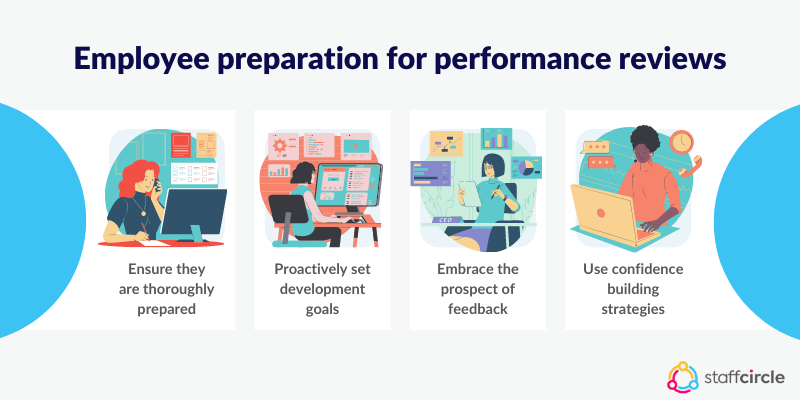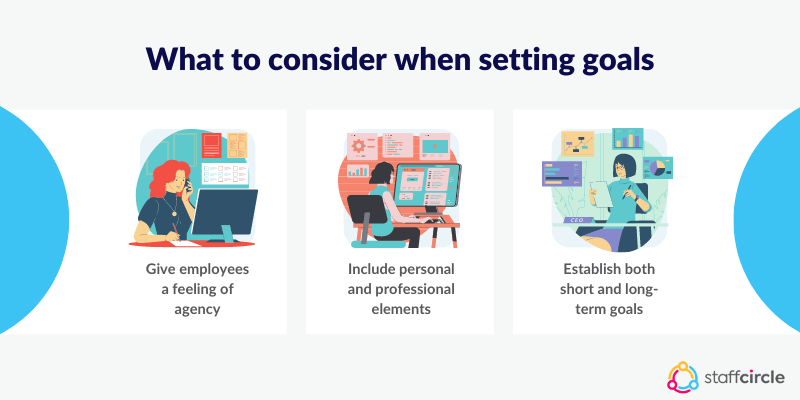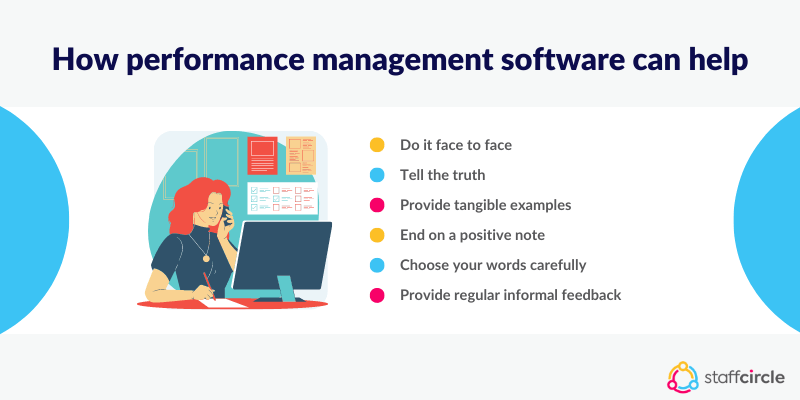Finding positive things to say in a performance review is an essential aspect of the performance management process. They allow managers to focus on an employee’s strengths and weaknesses, enhancing the former while working to resolve the latter.
This performance review guide will help you craft a performance review process that boosts employee morale and enhances productivity. By using performance management software, performance reviews can be set up and maintained to deliver consistently excellent results.
What is an employee performance review?
An employee performance review is a formal assessment that managers use to evaluate an employee’s past work performance. These reviews consider a range of performance-related measures, highlighting strengths and weaknesses while establishing new goals for the future.
Sometimes referred to as performance evaluations or appraisals, these reviews can be conducted at various intervals. While many organizations traditionally restrict these reviews to once per year, more businesses have adopted the process of monthly and quarterly reviews for their staff.
An article from the Harvard Business Review, The Performance Management Revolution, explains why regular conversations are now trumping annual reviews:
“With their heavy emphasis on financial rewards and punishments and their end-of-year structure, they hold people accountable for past behavior at the expense of improving current performance and grooming talent for the future, both of which are critical for organizations’ long-term survival. In contrast, regular conversations about performance and development change the focus to building the workforce your organization needs to be competitive both today and years from now.”
These frequent reviews can be fully orchestrated through performance management software. Such software delivers a range of tools that help ensure the reviews are comprehensive and run smoothly. Setting up review questions and scheduling the one2one meetings can all be helped with the templates and automated schedules provided by performance management software.
Why should I worry about what to say in a performance review?
Whether they are conducted every month or annually, performance reviews are an essential moment for employees and managers alike. They help all parties get a clear insight into how the employee is developing within their role and where their career is going in the future.
Performance reviews also allow employees to bring issues to their manager’s attention that might have been overlooked during the working day. They open up clear two-way lines of communication that can smooth over performance-related issues that affect the quality of work so that any necessary corrective measures can be taken.
As such, employees should take the time to prepare themselves before performance reviews to ensure they have considered all aspects of their performance. A performance review can be uncomfortable even when the employee has performed sterling work, and a failure to prepare can lead to heightened anxiety.

As well as making sure they are thoroughly prepared, employees can work to reduce anxiety and stress around their performance reviews by:
- Proactively setting new goals for themselves. One of the key functions of a performance review is establishing new goals, so employees who come prepared with their own suggestions demonstrate they understand the process’s function and take it seriously.
- Embracing the prospect of feedback to develop and grow. Receiving feedback is all about having the right mindset, and while one person may take criticism badly, another will embrace it as an opportunity to improve. Adopting the mindset of feedback as a growth opportunity will relieve any anxiety when it is delivered.
- Adopting confidence-building strategies. Anxiety can also be alleviated by adopting various confidence-building measures that help the employee maintain a positive outlook. This can include writing down a list of their positive accomplishments so that the performance review is approached with greater assurance.
What should be included in an employee performance review?
When conducting a performance review, there are a number of basic elements all reviews should include. These elements are there to ensure the fundamental outcomes of the review are met so that the manager and employee can leave the review with a clear vision of future expectations.
Performance reviews – The basics
Let’s take a closer look at the basic requirements of a performance review that should be included in all types of performance reviews, regardless of the frequency.
Set specific achievable goals
There are several methods managers use to establish goals for their employees. Some, such as stretch goals (sometimes called Big Hairy Audacious Goals), are perfect for pushing employees to develop their skills to their fullest potential. Others, such as SMART goals (an acronym for Specific, Measurable, Achievable, Relevant, and Time-Bound), are tailored for shorter-term goals.
With performance reviews, the latter goal-setting method is the most commonly used, with stretch goals typically associated with Performance Development Plans and general career progression planning.
When setting these goals, managers should also consider:
- Giving employees a feeling of agency over their goals. When employees participate in the process of setting goals, the sense of ownership increases their likelihood of success.
- Including an element of personal and professional growth. If an employee shows a particular aptitude for a given skill, try to set goals that allow them to hone and perfect this skill for a more rounded overall talent stack.
- Establishing both short- and long-term goals. Goals can be enhanced by pairing SMART and stretch goals for optimal performance, tying these goal types together so that short-term progress is associated with a bigger picture.

Two-way communication
Performance reviews should not be viewed as an opportunity to lecture employees about their failings. Instead, managers should approach reviews as an opportunity to learn about the challenges and obstacles employees face that might otherwise be overlooked. As such, two-way communication is essential if the review fulfills its purpose.
This requires understanding some of the fundamental people management skills all managers should embody. They should be able to communicate their performance evaluation clearly and concisely while simultaneously listening intently to employees’ responses. Likewise, employees should respond in kind, taking on board the feedback given so they can process a constructive response.
Be positive and honest
Performance reviews deliver the best outcomes for all involved when they are approached with a positive mindset. Criticisms and failures raised by managers should be framed with a solution in mind so that employees can take something away from the conversation that gives them an opportunity to improve.
This doesn’t mean glossing over shortcomings to the point where the employee doesn’t take them as seriously as they should. Instead, it requires managers to deliver honest criticism that shines a light on a positive vision of the future.
How can performance management software help?
Human resources professionals have been steadily moving away from the traditional paper and filing cabinet approach to HR operations for some time. The advent of powerful performance management software with HR administration tools integrated into their processes has further accelerated this trend.
Today, business leaders have primarily adopted a fully digital approach to management and administration. These performance management tools can smoothly automate processes while allowing managers and HR professionals responsible for carrying out the performance reviews to do so with minimal wasted time and effort.
Let’s take a closer look at some aspects of performance reviews that performance management software can assist with.
Do it face to face
Whenever possible, a performance review should be conducted face-to-face. Performance management software can be used to schedule these face-to-face meetings while delivering reminders so that all parties can be fully prepared.
Performance management software also allows performance reviews to be carried out digitally, for instance, when employees work remotely. Integrating programs such as Microsoft Teams into the performance management software allows reviews to be conducted using video conferencing tools.
Indeed, creating performance reviews using Microsoft Teams can be easily achieved, with users able to easily select the review type, date and time, and relevant employee required for the review.
Tell the truth
“Honesty is the best policy” may be a well-worn adage, but telling the truth should be a fundamental bedrock when approaching a performance review. This can be backed up with performance-related data and insights from the performance management software.
Whenever possible, all feedback should be backed up with data that demonstrates its truthfulness so that employees clearly know managers aren’t basing this feedback on their subjective opinions. Performance management software delivers powerful data analytics, insights, and trends so that managers can show employees how their performance has changed over time.

Give regular informal feedback
A good performance review should be seen as a checkpoint in an ongoing process of continuous feedback. It is by no means a replacement for ongoing conversations, which are essential for keeping employees aligned with the company’s core objectives on a day-to-day basis.
Another advantage of using performance management software as part of the review process is drawing upon data from real-time performance feedback. This allows managers to identify potential problems with performance as and when they arise, tackling them head-on rather than waiting until the next formal review comes around.
Use tangible and relevant examples
Vague and generalised feedback is of little use to employees when it comes to taking action to rectify performance issues. Managers should set out to back up all feedback with tangible and relevant examples so that employees are completely clear on where they need to improve.
Rather than telling them their work is subpar, provide specific examples along with counter-examples of how it should have looked. If an employee is persistently late or taking frequent absences, use HR administrative data from performance management software to show precisely their pattern of absences or late arrivals.
Performance management systems capture a broad range of information, from progress towards employee objectives and key results to 360 feedback and awards and recognition from their peers to deliver a wide range of insights into performance. Make sure this is clearly referenced when carrying out a performance review.
Choose your words carefully
Great leaders are those who are capable of adapting their verbal style to suit a particular employee. While some employees might appreciate frank and blunt feedback, others may be more prone to anxiety and nerves, in which case a more tactful and diplomatic choice of words is appropriate.
When conducting a performance review, managers should choose their words carefully. Be precise about any issues which are being discussed, whenever possible speaking in objective terms.
End on a positive note
The last impressions a manager makes in a performance review are the ones the employee will go away from the meeting remembering the most. As such, ending on a positive note is the best way to set them up for future success. Placing their strengths and achievements at the forefront of closing statements is an effective way to help employees leave with a positive mindset.
An article from Gallup that outlines the importance of inspiring employees through performance reviews highlights the crucial role employee development plays in delivering this result:
“To retain and engage top talent, managers should create reviews that look to the future and align employees’ overall life, work and aspirations. This means prioritizing developmental needs, such as special projects, skills training or mentoring experiences, just as much as immediate performance metrics and goals.”
Managers can use performance management software to align performance reviews to future coaching and training programs, giving employees a clear objective to work to moving forwards.
Performance review phrases to use during a self-evaluation
When carrying out a self-evaluation for a performance review, there are several useful phrases to consider including. These will help demonstrate proficiency across various work-related dimensions, from punctuality and timeliness to the quality of work delivered.
Consider using some of the following phrases in a self-evaluation:
- I consistently arrive at work on time and have an exemplary attendance record.
- I am consistently positive in my outlook and always try to remain cheerful and cooperative with colleagues.
- When faced with intense pressure, I remain cool and calm and tackle problems head-on to find objective solutions.
- I always try to approach my projects with a creative mindset so that I can bring something fresh to the table.
- My client’s feedback is consistently positive, with high levels of satisfaction.
- I recognise the areas for improvement that will best develop me within the role and work towards developing these areas.
- I respect other people’s time and resources and strive to arrange meetings around their schedules.
- I always aim to communicate clearly and concisely with others and listen to their responses so that I can act in their best interests.
Positive things to say in a performance review
We’ve touched upon the necessity for an overall positive mindset when approaching how to handle a performance review. Now let’s review some of the positive things that can be said by managers during a performance review to help improve confidence and motivate employees.
- Your communication skills are excellent, expressing your thoughts and suggestions clearly and respectfully.
- Your colleagues appreciate your willingness to listen and offer constructive feedback on their problems.
- You are a creative individual whose out-of-the-box thinking is an asset to your team.
- You’re a strong team player who excels at collaborative processes.
- You effectively establish and build meaningful relationships with those around you.
- You demonstrate a willingness to learn new things that will help you perform your role to greater proficiency.
- You are an effective strategiser capable of brainstorming multiple potential solutions to problems.
- You regularly develop flexible action plans and put them into practice with a clear understanding of expectations.
In Summary
Performance reviews allow managers to get to the root cause of performance-related issues employees face. At the same time, they allow managers to gather much-needed feedback from employees to help them to understand better the challenges they are facing in the workplace.
By following the principles outlined in this guide, managers and employees can transform performance reviews into a positive experience in which morale is boosted and productivity is enhanced.





